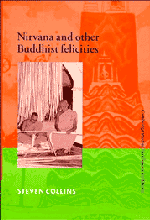Book contents
- Frontmatter
- Contents
- Preface and acknowledgments
- List of abbreviations
- Textual chronology
- General introduction: Buddhism and civilizational history 1 – structures and processes
- PART 1 NIRVANA IN AND OUT OF TIME
- Introduction to part 1: systematic and narrative thought - eternity and closure in structure and story
- 1 The concept of nirvana
- 2 The imagery of nirvana
- 3 Nirvana, time and narrative
- Conclusion to part 1: modes of thought, modes of tradition
- PART 2 PARADISE IN HEAVEN AND ON EARTH
- Appendices (translated texts)
- Bibliography
- Glossary and index of Pali and Sanskrit words
- Name index
- Subject index
3 - Nirvana, time and narrative
Published online by Cambridge University Press: 18 December 2009
- Frontmatter
- Contents
- Preface and acknowledgments
- List of abbreviations
- Textual chronology
- General introduction: Buddhism and civilizational history 1 – structures and processes
- PART 1 NIRVANA IN AND OUT OF TIME
- Introduction to part 1: systematic and narrative thought - eternity and closure in structure and story
- 1 The concept of nirvana
- 2 The imagery of nirvana
- 3 Nirvana, time and narrative
- Conclusion to part 1: modes of thought, modes of tradition
- PART 2 PARADISE IN HEAVEN AND ON EARTH
- Appendices (translated texts)
- Bibliography
- Glossary and index of Pali and Sanskrit words
- Name index
- Subject index
Summary
In the first two chapters, describing nirvana as a concept in systematic thought, and as embodied in and/or illustrated by imagery, I have quoted from many texts, and referred to still more, but with the partial exception of those from the Udāna and its commentary discussed in 1.2.c no attempt was made to deal with extended passages, whose literariness would demand its own attention and interpretative care. In this chapter I begin to attempt that, and continue to do so throughout the rest of the book. My concern here is with the way the Pali imaginaire textualizes time, and with nirvana as a narrative closure-marker, both in narrated time and in the time of narration. The texts discussed are the Buddhavamsa and Mahāvamsa; section 3.4. a looks briefly at the vamsa genre in general, and these two texts in particular, while sections 3.4.b and c offer interpretations of them based on a close reading of the relevant selections, which are translated in Appendices 1 and 2. But before coming to that, it is necessary to criticize and dismiss what I propose to call “the myth of The Myth of the Eternal Return,” which makes a wholly misleading and completely mistaken dichotomy between “the West and the rest,” claiming that “western” time is linear, and aligned with a propensity towards history, while elsewhere – notably in “the East” – time is cyclical, and aligned with a propensity to myth.
- Type
- Chapter
- Information
- Nirvana and Other Buddhist Felicities , pp. 234 - 281Publisher: Cambridge University PressPrint publication year: 1998

